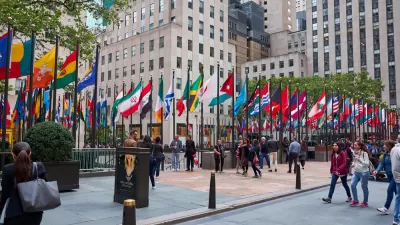Strategies for securing public spaces from vehicle attacks and other acts of terrorism without sacrificing accessible, vibrant urban places.

How can cities better protect people in public spaces from vehicle attacks and other threats? Writing in Bloomberg CityLab, John Surico attempts to unpack this question in the wake of the deadly attack in New Orleans, in which a truck was used to kill over a dozen people as protective bollards were being replaced.
According to Rob Reiter, a security consultant who specializes in vehicle attacks, says cities should more carefully evaluate potential “collision points” where pedestrian-heavy corridors intersect with roadways open to vehicle traffic. Reiter points to New York City’s low-tech intervention for New Year’s Eve: “dozens of garbage and dump trucks laden with sand, parked bumper-to-bumper to block any intrusions,” providing a practically impenetrable perimeter.
Outside of special events, cities can use “sculptural barriers,” trees, and other decorative — but solid — items to create a “positive perimeter” that offers protection without creating a hostile environment.
Surico concludes that “The long-term benefits of security improvements can’t necessarily be counted in just lives saved. Just as a community that’s more hospitable to older adults or children is more hospitable to everyone else, too, making spaces better protected from vehicle attacks can also just make them better, period.”
FULL STORY: What Can Cities Do to Protect Public Spaces From Vehicle Attacks?

Alabama: Trump Terminates Settlements for Black Communities Harmed By Raw Sewage
Trump deemed the landmark civil rights agreement “illegal DEI and environmental justice policy.”

Planetizen Federal Action Tracker
A weekly monitor of how Trump’s orders and actions are impacting planners and planning in America.

The 120 Year Old Tiny Home Villages That Sheltered San Francisco’s Earthquake Refugees
More than a century ago, San Francisco mobilized to house thousands of residents displaced by the 1906 earthquake. Could their strategy offer a model for the present?

In Both Crashes and Crime, Public Transportation is Far Safer than Driving
Contrary to popular assumptions, public transportation has far lower crash and crime rates than automobile travel. For safer communities, improve and encourage transit travel.

Report: Zoning Reforms Should Complement Nashville’s Ambitious Transit Plan
Without reform, restrictive zoning codes will limit the impact of the city’s planned transit expansion and could exclude some of the residents who depend on transit the most.

Judge Orders Release of Frozen IRA, IIJA Funding
The decision is a victory for environmental groups who charged that freezing funds for critical infrastructure and disaster response programs caused “real and irreparable harm” to communities.
Urban Design for Planners 1: Software Tools
This six-course series explores essential urban design concepts using open source software and equips planners with the tools they need to participate fully in the urban design process.
Planning for Universal Design
Learn the tools for implementing Universal Design in planning regulations.
Clanton & Associates, Inc.
Jessamine County Fiscal Court
Institute for Housing and Urban Development Studies (IHS)
City of Grandview
Harvard GSD Executive Education
Toledo-Lucas County Plan Commissions
Salt Lake City
NYU Wagner Graduate School of Public Service




























